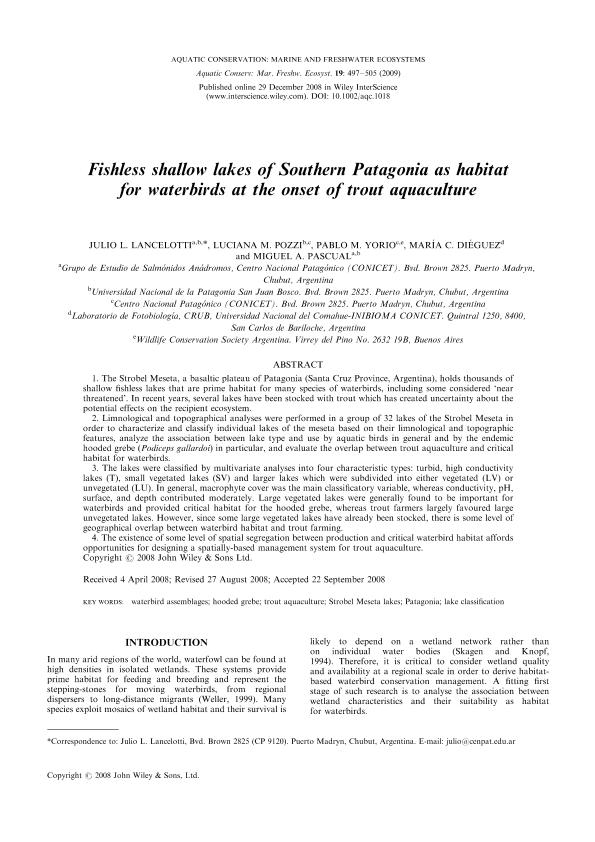Mostrar el registro sencillo del ítem
dc.contributor.author
Lancelotti, Julio Lucio

dc.contributor.author
Pozzi, Luciana Melina

dc.contributor.author
Yorio, Pablo Martin

dc.contributor.author
Dieguez, Maria del Carmen

dc.contributor.author
Pascual, Miguel Alberto

dc.date.available
2022-11-29T12:05:53Z
dc.date.issued
2009-12
dc.identifier.citation
Lancelotti, Julio Lucio; Pozzi, Luciana Melina; Yorio, Pablo Martin; Dieguez, Maria del Carmen; Pascual, Miguel Alberto; Fishless shallow lakes of Southern Patagonia as habitat for waterbirds at the onset of trout aquaculture; John Wiley & Sons Ltd; Aquatic Conservation: Marine and Freshwater Ecosystems; 19; 5; 12-2009; 497-505
dc.identifier.issn
1052-7613
dc.identifier.uri
http://hdl.handle.net/11336/179337
dc.description.abstract
1. The Strobel Meseta, a basaltic plateau of Patagonia (Santa Cruz Province, Argentina), holds thousands of shallow fishless lakes that are prime habitat for many species of waterbirds, including some considered 'near threatened'. In recent years, several lakes have been stocked with trout which has created uncertainty about the potential effects on the recipient ecosystem. 2. Limnological and topographical analyses were performed in a group of 32 lakes of the Strobel Meseta in order to characterize and classify individual lakes of the meseta based on their limnological and topographic features, analyze the association between lake type and use by aquatic birds in general and by the endemic hooded grebe (Podiceps gallardoi) in particular, and evaluate the overlap between trout aquaculture and critical habitat for waterbirds. 3. The lakes were classified by multivariate analyses into four characteristic types: Turbid, high conductivity lakes (T), small vegetated lakes (SV) and larger lakes which were subdivided into either vegetated (LV) or unvegetated (LU). In general, macrophyte cover was the main classificatory variable, whereas conductivity, pH, surface, and depth contributed moderately. Large vegetated lakes were generally found to be important for waterbirds and provided critical habitat for the hooded grebe, whereas trout farmers largely favoured largeunvegetated lakes. However, since some large vegetated lakes have already been stocked, there is some level of geographical overlap between waterbird habitat and trout farming. 4. The existence of some level of spatial segregation between production and critical waterbird habitat affords opportunities for designing a spatially-based management system for trout aquaculture.
dc.format
application/pdf
dc.language.iso
eng
dc.publisher
John Wiley & Sons Ltd

dc.rights
info:eu-repo/semantics/openAccess
dc.rights.uri
https://creativecommons.org/licenses/by-nc-sa/2.5/ar/
dc.subject
HOODED GREBE
dc.subject
LAKE CLASSIFICATION
dc.subject
PATAGONIA
dc.subject
STROBEL MESETA LAKES
dc.subject
TROUT AQUACULTURE
dc.subject
WATERBIRD ASSEMBLAGES
dc.subject.classification
Ecología

dc.subject.classification
Ciencias Biológicas

dc.subject.classification
CIENCIAS NATURALES Y EXACTAS

dc.title
Fishless shallow lakes of Southern Patagonia as habitat for waterbirds at the onset of trout aquaculture
dc.type
info:eu-repo/semantics/article
dc.type
info:ar-repo/semantics/artículo
dc.type
info:eu-repo/semantics/publishedVersion
dc.date.updated
2022-01-06T14:56:35Z
dc.journal.volume
19
dc.journal.number
5
dc.journal.pagination
497-505
dc.journal.pais
Reino Unido

dc.journal.ciudad
Londres
dc.description.fil
Fil: Lancelotti, Julio Lucio. Consejo Nacional de Investigaciones Científicas y Técnicas. Centro Nacional Patagónico; Argentina. Universidad Nacional de la Patagonia. Facultad de Ciencias Naturales. Sede Puerto Madryn; Argentina
dc.description.fil
Fil: Pozzi, Luciana Melina. Consejo Nacional de Investigaciones Científicas y Técnicas. Centro Nacional Patagónico; Argentina. Universidad Nacional de la Patagonia. Facultad de Ciencias Naturales. Sede Puerto Madryn; Argentina
dc.description.fil
Fil: Yorio, Pablo Martin. Consejo Nacional de Investigaciones Científicas y Técnicas. Centro Nacional Patagónico; Argentina. Wildlife Conservation Society; Estados Unidos
dc.description.fil
Fil: Dieguez, Maria del Carmen. Consejo Nacional de Investigaciones Científicas y Técnicas. Centro Nacional Patagónico; Argentina. Universidad Nacional del Comahue; Argentina
dc.description.fil
Fil: Pascual, Miguel Alberto. Consejo Nacional de Investigaciones Científicas y Técnicas. Centro Nacional Patagónico; Argentina. Universidad Nacional de la Patagonia. Facultad de Ciencias Naturales. Sede Puerto Madryn; Argentina
dc.journal.title
Aquatic Conservation: Marine and Freshwater Ecosystems

dc.relation.alternativeid
info:eu-repo/semantics/altIdentifier/url/http://onlinelibrary.wiley.com/doi/10.1002/aqc.1018/abstract
dc.relation.alternativeid
info:eu-repo/semantics/altIdentifier/doi/http://dx.doi.org/10.1002/aqc.1018
Archivos asociados
